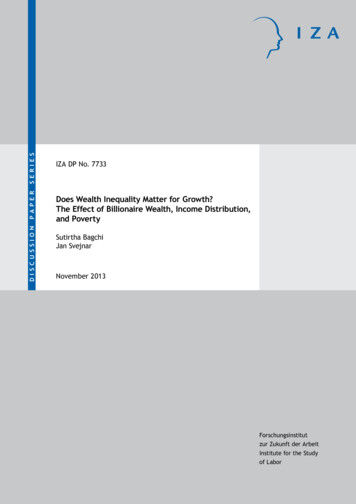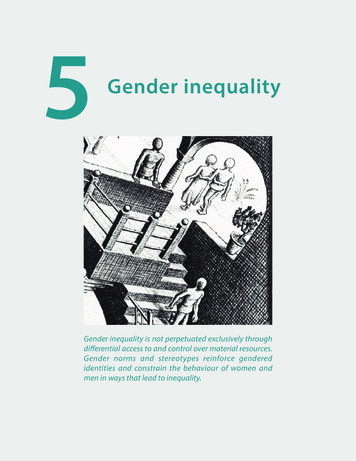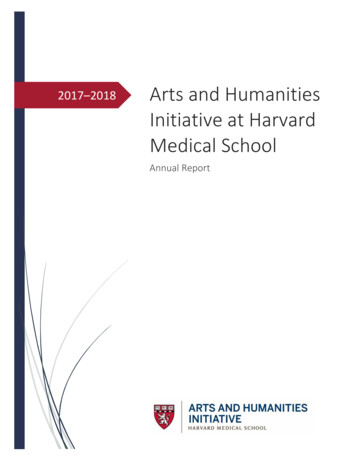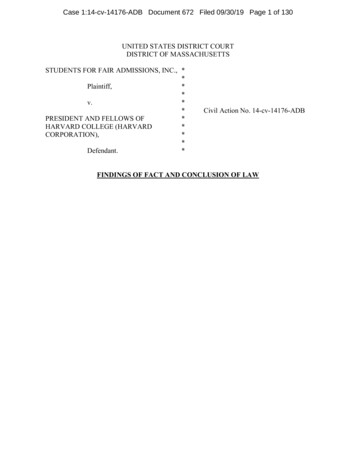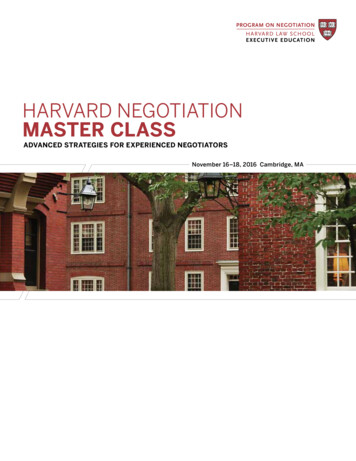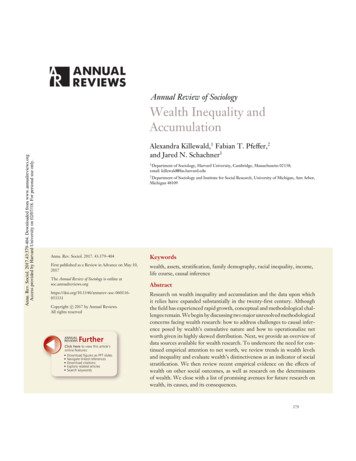
Transcription
SO43CH18-KillewaldARI20 July 201712:29Annual Review of SociologyAnnu. Rev. Sociol. 2017.43:379-404. Downloaded from www.annualreviews.orgAccess provided by Harvard University on 02/07/18. For personal use only.Wealth Inequality andAccumulationAlexandra Killewald,1 Fabian T. Pfeffer,2and Jared N. Schachner11Department of Sociology, Harvard University, Cambridge, Massachusetts 02138;email: killewald@fas.harvard.edu2Department of Sociology and Institute for Social Research, University of Michigan, Ann Arbor,Michigan 48109Annu. Rev. Sociol. 2017. 43:379–404KeywordsFirst published as a Review in Advance on May 10,2017wealth, assets, stratification, family demography, racial inequality, income,life course, causal inferenceThe Annual Review of Sociology is online urev-soc-060116053331c 2017 by Annual Reviews.Copyright All rights reservedANNUALREVIEWSFurtherClick here to view this article'sonline features: Download figures as PPT slides Navigate linked references Download citations Explore related articles Search keywordsAbstractResearch on wealth inequality and accumulation and the data upon whichit relies have expanded substantially in the twenty-first century. Althoughthe field has experienced rapid growth, conceptual and methodological challenges remain. We begin by discussing two major unresolved methodologicalconcerns facing wealth research: how to address challenges to causal inference posed by wealth’s cumulative nature and how to operationalize networth given its highly skewed distribution. Next, we provide an overview ofdata sources available for wealth research. To underscore the need for continued empirical attention to net worth, we review trends in wealth levelsand inequality and evaluate wealth’s distinctiveness as an indicator of socialstratification. We then review recent empirical evidence on the effects ofwealth on other social outcomes, as well as research on the determinantsof wealth. We close with a list of promising avenues for future research onwealth, its causes, and its consequences.379
SO43CH18-KillewaldARI20 July 201712:29INTRODUCTIONAnnu. Rev. Sociol. 2017.43:379-404. Downloaded from www.annualreviews.orgAccess provided by Harvard University on 02/07/18. For personal use only.In 2000, the Annual Review of Sociology (ARS) published two articles bringing sociologists’ attentionto wealth as a previously overlooked dimension of social inequality (Keister & Moller 2000,Spilerman 2000). Seventeen years later, the landscape of wealth inequality, wealth data, and wealthresearch has changed considerably. Although scholars have resolved several concerns raised bySpilerman and Keister & Moller, the proliferation of data and research has raised new questionsand highlighted the lack of consensus about basic modeling decisions. In many ways, then, thefield has moved from its infancy to its adolescence: It has experienced tremendous growth andprogress, but substantial room remains for continued development, particularly in understandingwealth-generating processes.In this article, we offer guidance to sociologists interested in studying wealth inequality andaccumulation. In Part I, we highlight conceptual and methodological challenges of analyzingwealth. Rather than treating these concerns as secondary to substantive findings, we considerthem fundamental to the success of future research on wealth’s causes and consequences. InPart II, we discuss wealth data sources and provide updated trends in levels and inequality ofUS wealth through the Great Recession. We then document how closely related wealth is to amore common measure of socioeconomic status: income. We show that methodological decisionshave implications even for a question as simple as the strength of the income-wealth association.Finally, in Part III, with an eye to the methodological and conceptual challenges outlined in Part I,we review substantive evidence for wealth’s effects on other outcomes, as well as research on thedeterminants of wealth, emphasizing studies published since the 2000 ARS pieces.Several recent studies have described the increasing concentration of wealth at the very top ofthe distribution (Kopczuk & Saez 2004, Saez & Zucman 2016), including an ARS article focusedon the one percent (Keister 2014). Here we highlight that wealth is also an important dimensionof stratification for a broader range of households. In other words, we conceptualize wealth notmerely as an aspect of closure among economic elites but as a population-wide phenomenon.PART I: CONCEPTUAL AND METHODOLOGICAL CHALLENGESIN THE ANALYSIS OF WEALTHWealth as a Cumulative MeasureWealth is typically measured as net worth: the sum of the value of a household’s assets, less thevalue of debts. Whereas income measures the flow of financial resources at a particular time,wealth is a cumulative stock that reflects years of prior circumstances and decisions. This featureraises several analytic concerns, particularly with regard to causal inference. Associations betweenparental wealth and offspring outcomes net of other parental socioeconomic status (SES) controlsmay merely capture spurious associations, including those due to measurement or specificationerror in the other SES variables. This concern is heightened if other predictors are point-intime, given that wealth carries traces of prior experiences. For example, if offspring outcomes areaffected by parental income throughout childhood, but parental income is measured in a singleyear, the association between parental wealth and offspring outcomes may merely reflect wealth’sassociation with permanent income, net of current income. Averaging income measures acrossseveral preceding years, when possible, reduces this concern.The cumulative nature of wealth has similar implications when it is the dependent variable.Scholars may wish to examine how wealth levels differ by race, gender, and social origins, and towhat extent this variation is accounted for by other determinants of wealth, such as education andincome. Typically, these latter determinants are measured only contemporaneously with wealth.380Killewald·Pfeffer·Schachner
Annu. Rev. Sociol. 2017.43:379-404. Downloaded from www.annualreviews.orgAccess provided by Harvard University on 02/07/18. For personal use only.SO43CH18-KillewaldARI20 July 201712:29For example, scholars sometimes measure the racial wealth gap unexplained by differences incurrent income levels, rather than the difference unexplained by differences in lifetime incomestreams to date. Again, averaging income over multiple years, when possible, can alleviate thisconcern. Although income is the most obvious variable with cumulative effects on wealth, othertime-varying wealth determinants, such as marriage and neighborhood context, are subject to thesame challenge.An alternative approach is to model wealth accumulation rather than net worth, using eitherlagged dependent variables or change models (e.g., Conley 2001b, Hurst et al. 1998, McKernanet al. 2014, O’Brien 2012). The advantage is that, rather than requiring lifetime histories of relevantcovariates, fewer data points may suffice; characteristics in one period (including wealth) mayapproximate the relevant set of factors determining wealth gain or loss achieved by the next period.Wealth’s status as a cumulative measure becomes even more problematic in the presenceof reverse causality concerns. Marriage, health, residential selection, homeownership, selfemployment, and portfolio composition are all characteristics that may both be shaped by priorwealth and shape subsequent wealth. Panel methods estimating within-individual change can reduce reverse causality concerns. Alternatively, macroeconomic fluctuations or policy changes canserve as exogenous shocks facilitating identification of wealth effects on various outcomes. For example, Lovenheim & Reynolds (2013) exploit exogenous variation in housing value trends acrossmetropolitan statistical areas to estimate the effects of parental home appreciation on offspringcollege attendance, choice, and completion.Still, these methods are not a panacea. For example, first-difference models might estimate theshort-term wealth consequences of unemployment or health shocks, but they cannot reveal howchronic exposure to unemployment or illness cumulatively affects wealth in later life: Narrowingthe time window comes at the expense of fully capturing early life experiences’ downstream wealtheffects. An alternative is marginal structural models, estimated with inverse probability of treatmentweights, which offer one way to model dynamic selection processes over time (Robins et al. 2000).Killewald & Bryan (2016) use this approach to estimate the long-term wealth consequences oftime spent in homeownership.The difficulty of establishing causal relationships has complicated assessments of the processesby which wealth accumulation occurs and between-group wealth disparities arise. In Part III, weargue that future research must seriously engage the methodological challenges posed by wealth’scumulative nature in order to advance sociologists’ understanding of the causes and consequencesof wealth inequality. As described in Part II, advances in data availability, especially from long-termpanel studies, support this endeavor.Operationalizing an Error-Prone, Highly Skewed VariableScholars interested in studying wealth’s determinants or effects in net worth face a seeminglystraightforward question: how should net worth be operationalized? So far, there is no consensus on best practices. Given measurement error concerns, wealth measures would ideallybe averaged across several years to reduce attenuation bias when used as a predictor variable.However, this approach requires measures of wealth at multiple points, which are not alwaysavailable.A second problem is that the wealth distribution is highly right-skewed. Top-coding net worthvalues can help reduce the potential for unduly influential outliers. Using median regression,rather than conditional mean models such as ordinary least squares, also reduces the sensitivityof results to extreme observations. Another common solution is to log-transform net worth, butthis approach requires a decision about how to treat zero and negative values. When wealthwww.annualreviews.org Wealth Inequality and Accumulation381
ARI20 July 201712:29is an independent variable, these values may be incorporated with dummy variables indicatingnegative or zero net worth, or with a separate variable measuring log net debt. When wealthis the dependent variable, there is no straightforward solution, but some common strategies areconverting all negative values to a small positive value, shifting all values up by a sufficient amountthat the entire range is positive (a started log), or simply excluding nonpositive values. Recodingnegative values to a small positive value obscures relative net debt values and creates an outlier masspoint at the low end of the log net worth distribution (Friedline et al. 2015), so we advise against it.An alternative is the inverse hyperbolic sine (IHS) transformation, which can incorporate zero andnegative values, generating a function that is approximately linear close to zero and approximatelylogarithmic for large values (Friedline et al. 2015, Pence 2006).The transformation selected has important implications for the assumed pattern of associations between model predictors and net worth. The log transformation assumes that changesin the independent variables have multiplicative effects on net worth, whereas the untransformed specification assumes additive effects. Wealth transformations are therefore not an incidental technical decision but a conceptual choice with potential consequences for substantive conclusions. For instance, whether bequests increase wealth inequality (Boserup et al. 2016,Karagiannaki 2017) and whether whites experience greater wealth benefits of homeownership thanAfrican Americans and Hispanics (Killewald & Bryan 2016) depend on whether comparisons aremade in absolute or relative terms. Thus, scholars should justify their operationalization choicesand consider whether substantive conclusions change with alternative transformations of networth.Recent research has considered that both the consequences and the determinants of wealth varyacross the wealth distribution (e.g., Addo & Lichter 2013, Friedline et al. 2015, Killewald 2013,Maroto 2016). When wealth is a predictor, we recommend experimenting with flexible functionalforms in order to identify a well-fitting specification. When wealth is the dependent variable,considering the possibility of variation in effects across the distribution is more complicated.We describe two analytic techniques that can reveal such heterogeneity. The first, unconditionalquantile regression, estimates how changes in independent variables are associated with changes invarious quantiles of the outcome variable, net of control variables (Firpo et al. 2009, Killewald &Bearak 2014). Maroto (2016) uses this approach to show that differences in education, employment,and income explain a greater share of whites’ wealth advantage relative to African Americans andHispanics at the top of the wealth distribution than at the bottom. The second approach, pioneeredby DiNardo et al. (1996) for the study of wage distributions, offers a semiparametric method forreweighting distributions in order to simulate counterfactual scenarios. Sierminska et al. (2010)use this approach to simulate how the gender gap in wealth would change at different points inthe distribution if partnered women had the same characteristics as partnered men. Given thatwealth determinants may vary sharply across the wealth distribution, we encourage researchers touse these and other methods, rather than capture only mean differences.Annu. Rev. Sociol. 2017.43:379-404. Downloaded from www.annualreviews.orgAccess provided by Harvard University on 02/07/18. For personal use only.SO43CH18-KillewaldPART II: WEALTH DATA AND PATTERNSAdvances in Data AvailabilityOver the past several decades, collecting data on assets and debts has become more common inlarge-scale surveys fielded in the United States and abroad. Although we recognize that our listmay not be exhaustive, Table 1 describes more than two dozen major surveys that gather datato measure net worth. Many of the surveys are longitudinal and several cover multiple decades,allowing observation of wealth over a large portion of the life course and—for genealogical panel382Killewald·Pfeffer·Schachner
SO43CH18-KillewaldTable 1ARI20 July 201712:29Surveys with net worth dataAbbreviationDatasetOverviewSurvey yearsYears with wealthWealth datainformationcoverageAnnu. Rev. Sociol. 2017.43:379-404. Downloaded from www.annualreviews.orgAccess provided by Harvard University on 02/07/18. For personal use only.United States—nationalAdd HealthThe NationalLongitudinalStudy ofAdolescent toAdult HealthPanel of American adolescents ingrades 7–12 in 1994–1995(24–32 years old in 2008) withan oversample of black,Chinese, Cuban, and PuertoRican students1994–present2008All g panel of Americanhouseholds1980–presentYearlyAll householdmembersGSSGeneral SocialSurveyUntil 2008, a cross-sectionalsample of American adults, withan oversample of black adults incertain years. Starting in 2008, acombined rolling panel andcross-sectional sample1972–present2006, 2014IndividualHRSHealth andRetirementStudyPanel of American adults olderthan 50, with an oversample ofblack and Hispanic adults andresidents of Florida. Floridaoversample dropped after 19931992–presentEvery 2 yearsAll householdmembersNLSY79NationalLongitudinalSurvey of Youth1979Panel of 1957–1964 US birthcohorts, with an oversample ofblack, Hispanic, economicallydisadvantaged, andenlisted-military youths. Theeconomically disadvantaged andmilitary oversamples weredropped in 1990 and 1984,respectively.1979–presentEvery year from1985–1990 and1992–1994, everyother year from1996–2000, every4 years alSurvey of Youth1997Panel of 1980–1984 US birthcohorts, with an oversample ofblack and Latino adolescents1997–presentWhen respondent isage 18, 20, 25, and30, and firstinterview whenrespondent isindependentPartnersNSFHNational Surveyof Families andHouseholdsPanel of American households,with an oversample of blacks,Puerto Ricans, MexicanAmericans, single-parentfamilies, families withstepchildren, cohabitingcouples, and recently 001–2002Partners(Continued )www.annualreviews.org Wealth Inequality and Accumulation383
SO43CH18-KillewaldTable 1ARI20 July 201712:29(Continued )Years with wealthAnnu. Rev. Sociol. 2017.43:379-404. Downloaded from www.annualreviews.orgAccess provided by Harvard University on 02/07/18. For personal use only.AbbreviationDatasetOverviewSurvey yearsinformationWealth datacoverageNISNew ImmigrantSurveyPanel of documented immigrantsto the US in 20032003–20092003–2004 and2007–2009PartnersNSHAPNational SocialLife, Health,and AgingProjectPanel of 1920–1947 US birthcohorts, with an oversample ofblack and Hispanic adults2005–presentEvery 5 yearsAll householdmembersPSIDPanel Study ofIncomeDynamicsPanel of American families andtheir descendants’ families, withan oversample of low-incomefamilies. Additional samples ofimmigrant families were addedin 1997 and 2017, and a sampleof Latino families was added in1990 but dropped after 1995.1968–presentEvery 5 yearsbetween1984–1999, everyother year sincethenAll family/householdmembersSCFSurvey ofConsumerFinancesCross-sectional sample ofAmerican families, with 2 panelfollow-ups (1983 samplereinterviewed in 1986 and 1989;2007 sample reinterviewed in2009) and an oversample of thewealthy1983–presentEvery 3 yearsAll householdmembersSIPPSurvey of Incomeand ProgramParticipationRotating panel (until 2013),single panel changed every4 years (starting 2014) ofAmerican families, with anoversample of poor families1984–presentEvery year, withsome gapsAll householdmembersUnited States—subnationalL.A.FANSLos AngelesFamily andNeighborhoodSurveyPanel of households in LosAngeles County, with anoversample of poorneighborhoods and familieswith children and newrespondents added to remaincross-sectionally representative2000–20082000–2001 yPanel of 1957 high schoolgraduates in Wisconsin, plus 1randomly selected sibling1957–present1992, 2005, 2011PartnersHouseholdExpenditureSurvey/Surveyof Income andHousingCross-sectional sample ofAustralian households with, forthe HES only, an oversample ofmetropolitan households whosemain source of income was agovernment pension, benefit, orallowanceHES: 1974–presentSIH: 1994–presentHES: Every 6 yearssince 2003–2004SIH: Every 2 yearssince 2003–2004(except 2007–2008)All householdmembersOther countriesAustralia:HES/SIH(Continued )384Killewald·Pfeffer·Schachner
SO43CH18-KillewaldARITable 120 July 201712:29(Continued )Years with wealthAnnu. Rev. Sociol. 2017.43:379-404. Downloaded from www.annualreviews.orgAccess provided by Harvard University on 02/07/18. For personal use only.AbbreviationinformationWealth datacoverageDatasetOverviewSurvey yearsAustralia:HILDASurveyHousehold,Income andLaborDynamics inAustralia SurveyPanel of Australian households,with an additional sample addedin 20112001–presentEvery 4 years since2002All householdmembersCanada: SFSSurvey ofFinancialSecurityCross-sectional sample ofCanadian households in the 10provinces (territories areexcluded), with an oversample ofhigh-income areas1999–presentEvery 7 yearsAll householdmembersChina: CFPSChina FamilyPanel StudiesPanel of Chinese communities,families, and their descendants,with an oversample of fiveprovinces2010–presentEvery other yearAll familymembersFinland:HWSHouseholdWealth Survey4-year rotating panel of Finnishhouseholds, with an oversampleof high-income households1987–presentEvery 3 years since1994All householdmembersGermany:SOEPGerman SocioEconomicPanelPanel of German households,with immigrant and highincome subsamples added later1984–present1988 and every5 years since 2002All householdmembersItaly: SHIWSurvey onHouseholdIncome andWealthCross-sectional and partly panelsample of Italian households1965–presentEvery 2 years since1991All householdmembersJapan:JHPS/KHPSJapan HouseholdPanel SurveyKHPS (Keio Household PanelSurvey) and JHPS were separatepanels of Japanese householdsthat combined in 2014. KHPShad additional samples added in2007 and 2012.KHPS: 2004–presentJHPS: 2009–presentEvery yearAll householdmembersKorea:KLIPSKorea Labor andIncome PanelStudyPanel of Korean households, withnew respondents added toremain cross-sectionallyrepresentative1998–presentEvery yearAll householdmembersSwitzerland:SHPSwiss HouseholdPanelPanel of households living inSwitzerland1999–present2009, 2010, 2012,2016All Panel SurveyPanel of British households, withyouth panel added in 1994,Northern Ireland and GreatBritain low-income samplesadded in 1997, Scottish andWelsh samples added in 1999,Northern Ireland sample addedin 2001; incorporated intoUKHLS in 20101991–2008Every 5 years since1995All householdmembers(Continued )www.annualreviews.org Wealth Inequality and Accumulation385
SO43CH18-KillewaldTable 1ARI20 July 201712:29(Continued )Years with wealthAnnu. Rev. Sociol. 2017.43:379-404. Downloaded from www.annualreviews.orgAccess provided by Harvard University on 02/07/18. For personal use only.AbbreviationDatasetOverviewSurvey yearsinformationWealth y, UKHouseholdLongitudinalStudyPanel of UK households, with anoversample of ethnic minoritiesin original sample; sample ofimmigrants and ethnicminorities added in 2014–2015;incorporated BHPS in 20102009–presentEvery 4 years since2009–2010All householdmembersUnitedKingdom:WASWealth and AssetSurveyPanel of households in England,Scotland, and Wales, with newsamples added every 2 years toremain cross-sectionallyrepresentative2006–presentEvery 2 yearsAll householdmembersHFCSHouseholdFinance andConsumptionSurveySample of households in 15eurozone countries,representative at country andcontinental level, with panelcomponent and an oversampleof wealthy for some countries.The sample will expand toencompass 17 euro area memberstates beginning with the secondwave of the survey.2010/2011–presentEvery 3 yearsAll householdmembersISSPInternationalSocial SurveyProgrammeHarmonized versions of existingsamples of all adults in 30 countries1985–present2009All householdmembersLWSLuxembourgWealth StudyWealth microdata compiled fromvarious wealth surveys andharmonized for cross-nationalresearch, including Australia,Canada, Finland, Germany,Greece, Italy, Norway, SouthAfrica, Spain, Sweden, UnitedKingdom, United States,representative at country level.Datasets for Austria, Cyprus,Slovenia, and Slovak Republiccurrently being harmonized1995–presentEvery 3–5 yearsAll householdmembersSHARESurvey of Health,Ageing andRetirement inEuropePanel of adults 50 or over in20 European nations and Israel,with 7 new countries in the field2017–182004–presentEvery 2 yearsPartnersComparativestudies, such as the Panel Study of Income Dynamics (PSID) and its international sister studies—increasingly across generations. A few surveys, including the Survey of Consumer Finances(SCF) in the United States, oversample the wealthy to improve description of the top of thewealth distribution. The Luxembourg Wealth Study; the Household Finance and ConsumptionSurvey; the Survey of Health, Ageing and Retirement in Europe; and the International Social386Killewald·Pfeffer·Schachner
Annu. Rev. Sociol. 2017.43:379-404. Downloaded from www.annualreviews.orgAccess provided by Harvard University on 02/07/18. For personal use only.SO43CH18-KillewaldARI20 July 201712:29Survey Programme are multinational datasets that facilitate comparisons across many Westerncountries, but the availability of wealth data is expanding even to transition and developingcountries (Davies 2008, Xie & Jin 2015).Most surveys construct wealth as a household-level measure, although some treat the respondent and partner (if any) as the wealth-holding unit. One advantage of the latter approach is thatit enables the calculation of personal wealth for young adults still living with their parents. Inaddition, the German Socio-Economic Panel (SOEP) collects asset information at the individual level, including proportional ownership of jointly owned assets by couples, allowing separatewealth measures for each partner within couples.Among US datasets, the SCF collects the most detailed wealth information. Consequently, itis often used as a benchmark to judge the validity of wealth data collected in other surveys. ThePSID and Health and Retirement Study (HRS) compare favorably to the SCF up until at leastthe 95th percentile of the wealth distribution (Bosworth & Smart 2009, Juster et al. 1999, Pfefferet al. 2016), whereas the Survey of Income and Program Participation wealth data diverge moresharply (Curtin et al. 1989, Czajka et al. 2003).Administrative data can supplement or substitute for survey data on net worth. For example,HRS matches survey data to administrative data from the Social Security Administrationand employer-provided pension data to construct an augmented net worth measure capturing a broader range of resources available for future retirement (Hauser & Weir 2010).Scandinavian administrative data sources are particularly powerful because they provide veryhigh-quality wealth measures based on tax registers, often allowing the tracking of individualsacross their life course and of families across generations for the full population (e.g., Hällsten &Pfeffer 2017 for Sweden and Hansen 2014 for Norway). However, the phase-out of wealth taxationabolishes this data source for some countries, such as Sweden since 2008 (Hällsten & Pfeffer 2017).Trends in Wealth and Wealth InequalityKeister & Moller (2000) use data from the SCF and the 1962 Survey of the Financial Characteristicsof Consumers to estimate trends in the average level and overall distribution of net worth from 1962to 1995. In Table 2, we reproduce estimates from Pfeffer & Schoeni (2016) to describe trendsfrom 1989 to 2013. The first panel shows trends in wealth levels, including mean and medianhousehold wealth in thousands of dollars; the remainder of the table shows various measures ofnet worth inequality. Inequality in net worth increased in the second half of the twentieth century(Keister & Moller 2000) and still more in the new millennium: Between 2001 and 2013, the wealthshare owned by the top 1% increased from 32 to 36%. Inequality also increased throughout thedistribution. The ratio of wealth held by households at the 95th percentile relative to those atthe median increased from 15:1 to 23:1 and, for households at the median relative to those at the25th percentile, from 7:1 to 9:1.Inequality rose particularly rapidly during the Great Recession (Pfeffer et al. 2013, Wolff2016), and the trend persisted even as the official recovery began in 2009. The tremendous wealthdestruction wrought by the recession has left the median US household with less net worth in2013 than in 1995 ( 81,400 versus 87,700 in 2013 dollars). In contrast, mean wealth rose from 323,500 to 528,400 during the same time span, reflecting the disproportionate growth of wealthat the top as well as losses at the bottom: The share of households with no wealth or in net debtincreased from 9.7% to 12.9%.11Most net worth measures exclude pension wealth (augmented net worth). Survey collection on pension wealth is difficult,as individuals struggle to estimate the value of their entitlements from pension plans and Social Security (Curtin et al. 1989,www.annualreviews.org Wealth Inequality and Accumulation387
SO43CH18-KillewaldTable 2ARI20 July 201712:29Net worth .5522.1553.9625.2530.4528.4Annu. Rev. Sociol. 2017.43:379-404. Downloaded from www.annualreviews.orgAccess provided by Harvard University on 02/07/18. For personal use only.Percent with 0 or11.4%10.3%lessShare of household wealth owned op 1%29.9%30.1%34.8%33.8%32.1%33.2%33.6%34.1%35.5%Top 5%54.2%54.4%56.1%57.2%57.4%57.4%60.3%60.9%62.9%Top p ttom 50%3.0%3.3%3.6%3.0%2.8%2.6%2.5%1.2%1.1%Gini coefficientRatio of 9064,2994,3054,4424,5194,4176,4826,015Number ofobservationsNote: Reprinted with permission from Pfeffer & Schoeni (2016, table 1). RSF: The Russell Sage Foundation Journal of the Social Sciences, Volume 2, Issue 6.c Russell Sage Foundation, 112 East 64th Street, New York, NY 10065. Based on the Survey of Consumer Finances. Dollar values in thousands of 2013 dollars.Piketty’s (2014) Capital in the Twenty-First Century reveals similar aggregate wealth trendsthroughout the developed world. Building on prior publications, Piketty shows that wealth inequality has followed a U-shaped trajectory across most developed countries since 1900, with theupswing occurring in the United States since about 1970 and in Europe since about 1980. Pikettytraces the preceding declines in wealth inequality to war-induced asset devaluation, high tax rates,and skills investments spurring economic growth. He attributes the recent increase in wealth inequality to the rate of return to capital overtaking the economic growth rate (for critiques, seeAcemoglu & R
current income levels, rather than the difference unexplained by differences in lifetime income streams to date. Again, averaging income over multiple years, when possible, can alleviate this concern. Although income is the most obvious variable


